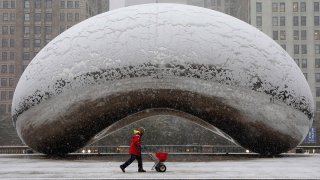
After bouts of snow in recent weeks, the Chicago area is seeing 50-degree temperatures and enjoyable conditions. But with it being late November, some are bracing for the chilly weather again.
Even though the snow and cold will likely come sooner, the official start to winter is still weeks away.
The first day of winter coincides with the winter solstice, which is also the shortest day of the year in terms of hours of sunlight.
The winter solstice marks the point when the North Pole is at its' furthest location away from the sun, creating the atmosphere for shorter hours of sunlight.
Feeling out of the loop? We'll catch you up on the Chicago news you need to know. Sign up for the weekly Chicago Catch-Up newsletter here.
According to the National Weather Service, this year's winter solstice will occur at 3:48 p.m. CST on Wednesday, Dec. 21, marking the official start of winter.
While the solstice and shortest day of the year will both occur on Dec. 21, the following day is recognized as the first full day of winter.
Though the day of the solstice is always marked, the solstice itself is only the moment that the northern hemisphere is tilted at its furthest point away from the sun, according to The Farmer's Almanac.
Local
As the solstice marks the changing of seasons, the event also holds significance to many cultures. Several ancient structures were built as ways to track the seasons, including Stonehenge in England and Newgrange in Ireland.
Additionally, the solstice can also be seen as the time in which the sun's path reaches its most southerly point of the sky, with the opposite effect being witnessed in the southern hemisphere.
According to the Farmer's Almanac, the word solstice originates from the Latin words sol and sistere, translating to "sun" and "to stand still" respectively, loosely translating to "sun stand still."
After the winter solstice concludes, the sun begins to advance northward all the way up until the summer solstice occurs in the northern hemisphere, marking the when the sun is most closely tilted to the hemisphere.
Despite starting near the end of the months they begin in, astronomical seasons and meteorological seasons both last for approximately three months.
Below is a list of the astronomical season changes we can expect to see following the upcoming winter solstice next month:
- Vernal Equinox (Spring): March 20, 2023, 4:24 p.m.
- Summer Solstice (Summer): June 21, 2023, 9:58 a.m.
- Autumnal Equinox (Fall): Sep. 23, 2023, 1:50 a.m.



